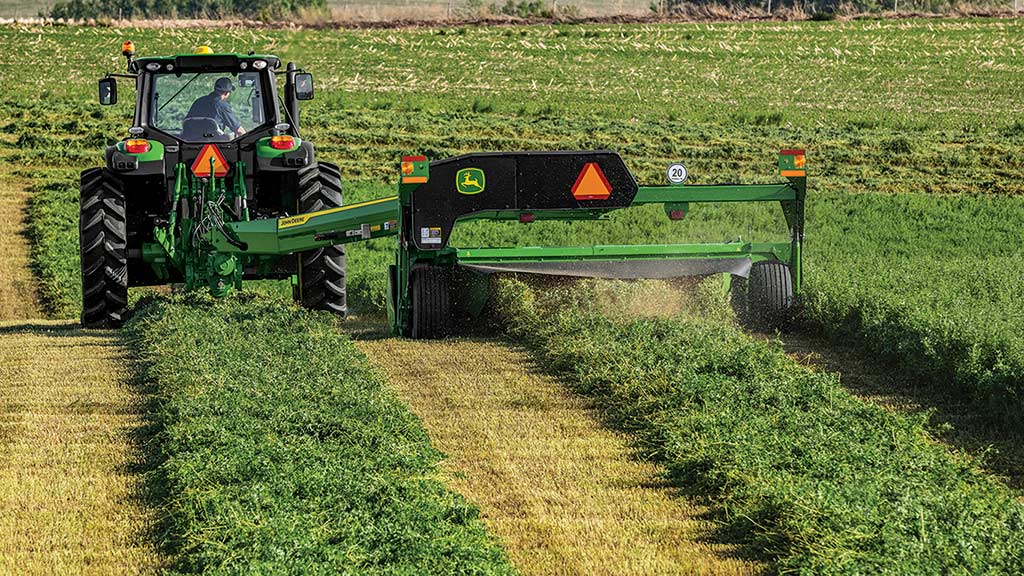Cutting hay isn’t always a quick and simple task, especially when you have a large amount of it to tackle in a single workday. Luckily, John Deere has several mower conditioners that customers can choose from to boost their efficiency and overall productivity. With a mower conditioner from Deere, agricultural professionals can cover more acres in a short amount of time. Deere’s latest mower conditioners are also lighter in weight and give users the ability to customize their windrow. Maneuverability and durability are also guaranteed with a mower conditioner from John Deere.

What is a Mower Conditioner Used For?
Mower conditioners have become a must-have for hay crop producers who value quality. This piece of equipment is designed to crimp and crush newly cut hay with the goal of promoting faster, even drying.
Mowers typically come as one of three types: sickle bar, disc, or drum. Sickle bar mowers use a reciprocating blade to cut grass and often have a reel to fold grass over the knife. Disc mowers use several hubs across the cutting width, and each hub has a small rotating disc with knives. Drum mowers come equipped with two or three large plates known as drums; these ride over the ground while spinning.
Conditioners also come in three main types: rubber-roller, steel-roller, and flail. Roller conditioners have two opposing rolls with a raised, interlocking pattern; these crimp the crop between the rollers. Flail conditioners have an arrangement of steel Vs on their main shaft, which beat the crop against the top of the mower conditioner.
How to Set Up & Operate a Mower Conditioner
Once you purchase a mower conditioner and you’re ready to use it out in your field, there are a few steps you can take to prepare for the task at hand.
- Start by reading your Operator’s Manual to familiarize yourself with all of the safety measures that need to be taken into consideration. It will also let you know how to attach your mower conditioner according to the hitch system you are using.
- Make sure the top of your drawbar is 13 to 20 inches above the ground surface.
- Verify that the distance from the top of the drawbar to the tractor’s PTO shaft centerline is 6 to 12 inches.
- Measure the distance from the end of the tractor’s PTO shaft to the drawbar pinhole centerline. The distance should be 14 inches for 540 rpm or 16 inches for 1000 rpm.
- Attach the PTO, secure the safety chain, attach the hydraulic hoses, and remove the jack stand.
- Return to the tractor cab to set the depth stop on the three-point control. After these steps have been completed, you will only need to make minor adjustments in the future, assuming the conditions remain consistent.
- Adjust the cutting height by adjusting the gauge shoes. Release the swing lock, then swing the mower conditioner out into the operating position.
- Verify that the lock cylinders are locked in place by moving the locking lever to the horizontal position.
- Remove the locking pins to raise or lower the gauge shoe on one side. Then, replace the locking pins to set the gauge shoe at the desired height.
- Adjust the cutterbar tilt using the turnbuckle to angle the cutterbar up or down.
- Adjust the float to keep the machine’s weight off of the cutterbar and on the float springs. This will allow the mower conditioner to follow the contour of the field.
- Adjust the windrow forming shields by loosening the two handles, adjusting the shields, and re-tightening the handles.
- Adjust the swath board by moving the adjustment handle forward to lower the board, or backward to raise it.
- Once you are out in the field, set the mower conditioner to operate off-center from the tractor. This will allow it to cut the standing hay while the tractor moves over the previously cut hay.
- Review the Operator’s Manual before you store the mower conditioner after use.
If you enjoyed this post or want to read others, feel free to connect with us on Facebook, Pinterest, Twitter, or Instagram!



